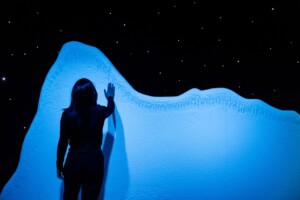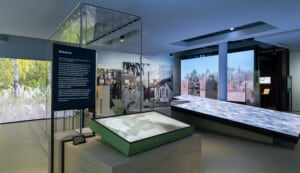The world tuned in to Sochi. But now the Winter Games are over, sports fans will be able to experience the rich diversity of the Olympics and their relationship with society as a whole through the lens of the revitalised Olympic Museum.
It’s not just about Olympic sport. It’s about history, culture, design, technology and all the things that have developed through Olympism. It’s a lens through which to observe society. – Frederique Jamolli, the Olympic Museum’s Head of International Cultural Development

The Olympic Museum is one of the largest projects that Paragon has undertaken. Drawing on their full range of skills – design development, fit-out, graphics, Corian works, model making, prop making, theming and of course interactives – Paragon worked closely with fellow British companies Centre Screen, Electrosonic, Metaphor and Mather and Co to create seamless immersive environments to entertain, thrill and motivate in an entertaining and memorable way.
Francis Gabet, Director of the Olympic Museum, spoke to Blooloop about Paragon’s contribution: “We required the project to be creatively driven by a main contractor but needed them to have the creative ability to control our ideas, content and budgets. This ability is hard to find in a main contracting company but this is where Paragon excelled.
“We wanted a company that could help cement a true team effort.
“Paragon could provide more in-house services than any other company, and this took a huge amount of pressure away from the project.
“Paragon ‘pre-built’ the entirety of the 60, 000 sq. foot Museum in their workshops in York whilst simultaneously the Museum building was being re-built in Lausanne.
“I am delighted to say we opened on time, within budget and have a Museum that is beyond our expectations.”

The Design:
Mark Pyrah (below), CEO of Paragon Creative, described the creative inspiration behind the Museum’s renovation and reinterpretation:
“We felt it important to overcome the preconception that this is simply a sports museum. The Olympic Museum  tells an epic story of triumph, victory and defeat, and most importantly a story of people. The content and scale of the museum had to represent these stories in a way that would do them justice.
tells an epic story of triumph, victory and defeat, and most importantly a story of people. The content and scale of the museum had to represent these stories in a way that would do them justice.
“We had to ask ourselves, ‘How do we take one of the largest events in the world every two years and place it into a very static space?’
“This museum isn’t about objects, it is about people. The objects access the stories about the people and had to be carefully selected and well displayed. Graphic interpretation, interactive exhibits and A/V displays are there to add layers of information and to help tell these stories in an emotional, dramatic and even fun way.”
The Museum: a Three-Strand Narrative
The Museum contrives through its narrative-style progression and immersive techniques to give the visitor a feel for what it is to be an Olympic athlete. Outside the Museum the steps from the Quai d’Ouchy to the entrance are engraved with the names of torchbearers who lit the Olympic flame.
In the grounds, bronze sculptures represent Olympic disciplines. A 110-metre corridor is used to enable visitors to appreciate the speed of Usain Bolt, the world’s fastest man with shafts of light illustrating his 9.58-second world record.
There are three permanent exhibition spaces – displaying 1500 items across 3000 square metres – which include a display of medals from every summer Games dating back to 1896; spaces for temporary exhibitions; a redesigned garden; a terraced cafe and a shop. The campus includes an Olympic Studies Centre and conference facilities as well as a children’s learning zone.
Gabet explained the creative process: “We planned it like a film. We worked with thematic clusters, like a storyboard… We want people to feel the earth, the grass, the excitement.”

Thematic Clusters, Like a Storyboard
The Museum leads the visitor through a three-strand narrative that is an exploration of the Olympics. The visit begins at the top of the four storey Museum and spirals downwards.
The first strand is the theme of The World – which examines the influence of the Olympics. Visitors are transported back through time to the origins of the Games in ancient Greece; then taken forward to Baron Pierre de Coubertin’s founding of the modern Olympics in 1894. The theme concludes by illustrating the diversity and creativity of host cities in devising opening ceremonies, torch design and stadium architecture.
The second strand –The Games – showcases sporting achievements from Summer and Winter Olympics through displays of athletes’ clothing and equipment and over 1000 video clips. Exhibits include the fencing foil and kit of Thomas Bach, new President of the International Olympic Committee (IOC); sprinter Michael Johnson’s golden running shoes and the retro-style skis of Jean-Claude Killy.

Olympic Spirit, the third strand, focuses on athletes’ mental and physical challenges; their health and nutrition and principles, for example anti-doping and fair play. Innovative materials that help boost performance are on display – high-tech shoes, and the alloys that have replaced bamboo for the high-jump. The less acceptable face of performance-boosting has not been glossed over: the work of WADA, the World Anti-Doping Agency, is explained and a display exhibits various chemical solutions.
Throughout the refurbished Museum, there has been a particular focus on interactivity and digital presentation.
Visitors can analyse their eating habits in a display dedicated to athlete’s nutrition before testing their balance and co-ordination with interactive activities based on biathlon, curling and slalom skiing.

The Museum features over 150 screens and a 180-degree cinema showing interviews with athletes and footage of past games and at the Museum’s heart, a gigantic array of screens showcases the athletes as they prepare for action.
The result is a totally immersive experience, drawing visitors into the athletes’ emotions.
Big champions are our role model, and their story is here. But we are not a hall of fame… We are not a history Museum. We are a Museum of an idea. – Francis Gabet in an interview with the New York Times

All images kind courtesy Paragon Creative













